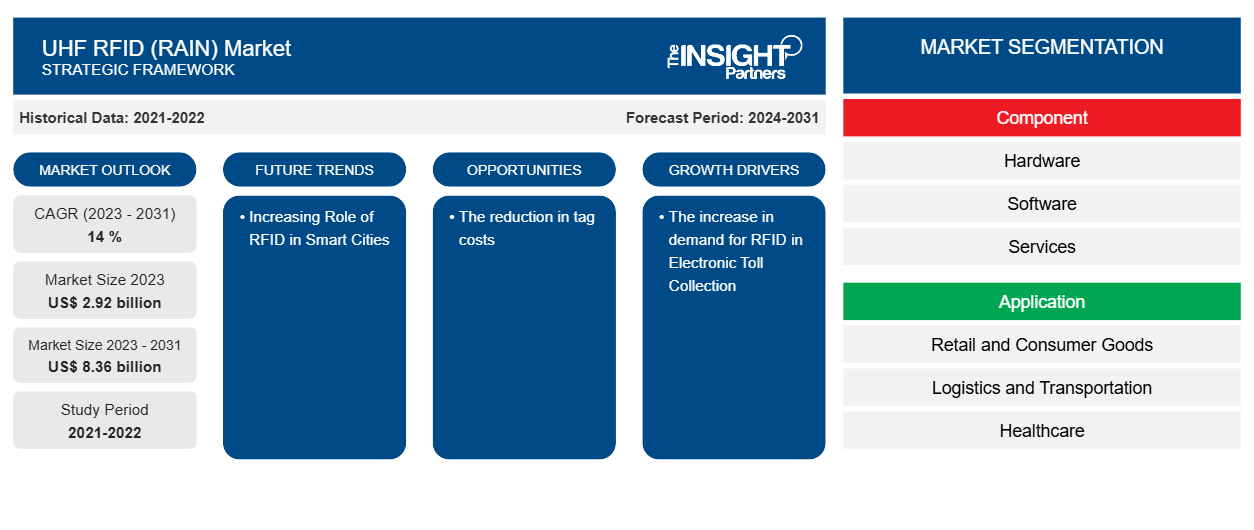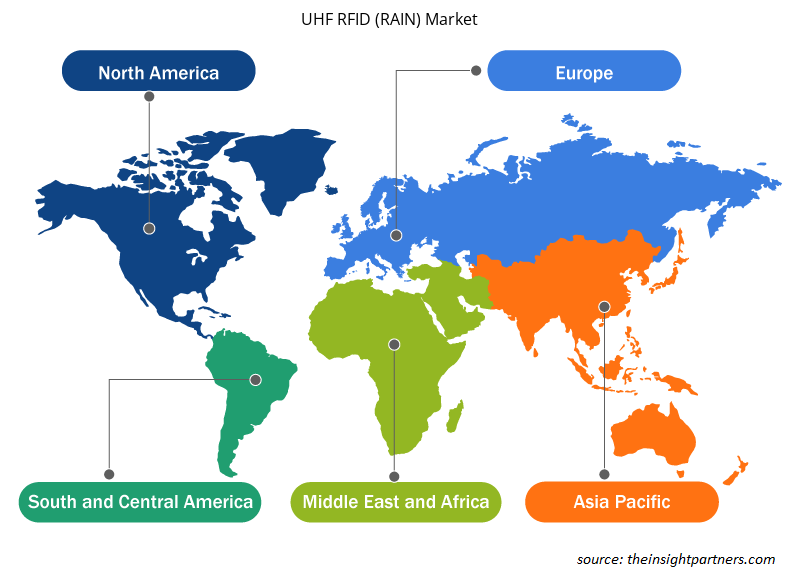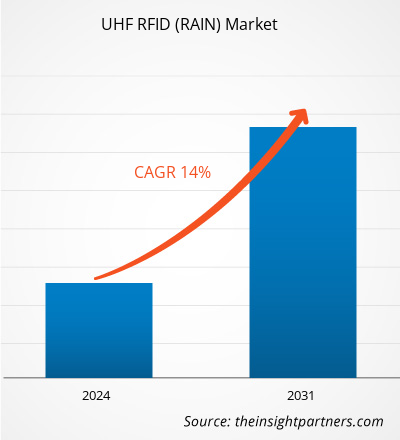Se proyecta que el tamaño del mercado de RFID UHF (RAIN) alcance los 14.070 millones de dólares estadounidenses para 2031, frente a los 4.620 millones de dólares estadounidenses de 2024. Se espera que el mercado registre una tasa de crecimiento anual compuesta (TCAC) del 17,9 % entre 2025 y 2031. Es probable que la creciente adopción en la industria automotriz traiga consigo nuevas tendencias al mercado en los próximos años.
Análisis del mercado de RFID UHF (RAIN)
RAIN (UHF RFID) es una tecnología inalámbrica que permite a organizaciones y consumidores identificar, localizar, verificar e interactuar con productos comunes conectándolos a internet. El espectro de RAIN se encuentra en la banda superior (entre 860 y 960 MHz) del rango de frecuencia ultraalta de la tecnología RFID y cumple con estándares y protocolos específicos. RAIN RFID es una tecnología pasiva, sin batería, que opera a frecuencias ultraaltas (UHF) y puede identificar artículos a distancias de hasta 15 metros. Puede reconocer hasta 1000 artículos por segundo, incluso sin línea de visión directa. La tecnología RAIN gestiona datos, actúa y lee y escribe artículos etiquetados mediante un lector. Estas capacidades permiten a empresas y clientes reconocer, encontrar, verificar e interactuar con cada objeto que tenga una etiqueta RAIN. RAIN ofrece datos e información completa en tiempo real para aplicaciones como la optimización de la cadena de suministro, el seguimiento de activos y la gestión de inventario.
Descripción general del mercado de RFID UHF (RAIN)
RAIN RFID se utiliza en los mercados para identificar, localizar y autenticar mercancías eficazmente. Se distingue de otras tecnologías del IoT por su disponibilidad, asequibilidad y facilidad de uso. Su capacidad para aumentar la visibilidad y proporcionar datos precisos la convierte en una tecnología revolucionaria en la era digital.
Personalice este informe según sus necesidades
Recibirá personalización de cualquier informe, sin cargo, incluidas partes de este informe o análisis a nivel de país, paquete de datos de Excel, así como también grandes ofertas y descuentos para empresas emergentes y universidades.
Mercado de RFID UHF (RAIN): Perspectivas estratégicas

-
Obtenga las principales tendencias clave del mercado de este informe.Esta muestra GRATUITA incluirá análisis de datos, desde tendencias del mercado hasta estimaciones y pronósticos.
Impulsores y oportunidades del mercado de RFID UHF (RAIN)
Creciente adopción de tecnologías RFID en el sector minorista
Los avances en las tecnologías de seguimiento de inventario y el énfasis en las herramientas de marketing online, como Facebook y Google Ads, impulsan el crecimiento del sector minorista. Es una de las industrias más consolidadas en Estados Unidos, donde los consumidores se inclinan por las compras online. Según la Oficina del Censo del Departamento de Comercio, las ventas minoristas de comercio electrónico en Estados Unidos alcanzaron los 1192.600 millones de dólares estadounidenses en 2024, lo que representa un aumento del 8,1 % con respecto a 2023.
En el sector minorista, se adopta la identificación por radiofrecuencia (RFID) para el etiquetado de prendas de vestir . Los proveedores de ropa están incorporando la digitalización y el análisis de big data en aplicaciones RFID. La tecnología RFID utiliza ondas de radio para transmitir datos desde las etiquetas RFID a un lector, lo que permite la identificación de objetos según los datos recibidos y facilita el seguimiento de su ubicación. Las organizaciones buscan soluciones asequibles que les permitan aumentar la eficiencia operativa y reducir los gastos generales. Datos de Accenture muestran que el 93 % de los minoristas norteamericanos utilizan RFID de alguna manera para lograr estos objetivos. Gigantes del sector minorista, como H&M, Lululemon, Zara y Nike, utilizan la tecnología RFID UHF para la gestión de inventario, lo que les ayuda a mantener una cadena de suministro eficaz, combatir las falsificaciones y prevenir la falta de existencias. Walmart exigió a sus proveedores de ropa que colocaran etiquetas RFID en sus productos en 2020. En 2022, la exigencia se amplió para incluir juguetes, productos electrónicos y otros artículos para el hogar. El mandato se amplió para abarcar todo, desde el suministro de automóviles hasta los productos deportivos, en 2023 y 2024. Para 2025, se espera que la mayoría de las demás categorías de productos que se venden en las tiendas Walmart estén cubiertas por este requisito. La implementación de estas iniciativas en el sector minorista impulsa el crecimiento del mercado en este segmento. RFID) is adopted for digitalization and Big Data analytics in RFID applications. RFID technology utilizes radio waves to transmit data from RFID tags to a reader, enabling the identification of objects based on the received data and facilitating the tracking of their locations. Organizations are seeking affordable solutions that enable them to increase operational efficiencies and reduce overhead costs. Data from Accenture shows that 93% of North American retailers are using RFID in some capacity to achieve these goals. Retail sector giants, such as H&M, Lululemon, Zara, and Nike, use UHF RFID technology for inventory management, helping them maintain an effective supply chain, combat counterfeit items, and prevent out-of-stock situations. Walmart mandated its clothing suppliers to attach RFID labels on their products in 2020. In 2022, the mandate was extended to cover toys, electronics, and other home items. The mandate expanded to cover everything from automotive supply to sporting products in 2023 and 2024. By 2025, the majority of other product categories that are sold in Walmart stores are expected to be covered by the requirement. The implementation of such initiatives in the retail sector drives the market growth in the segment.
Implementación de la tecnología RFID UHF en dispositivos IoT
La adopción de dispositivos inteligentes y las inversiones gubernamentales, especialmente en países como Japón, Singapur, China y Australia, centradas en la I+D y la instalación del Internet de las Cosas (IdC) en sectores como la manufactura, los servicios públicos y el comercio minorista, están impulsando el crecimiento del IdC. Las aplicaciones del IdC requieren una conexión de datos entre el mundo físico y el digital, y la tecnología RFID UHF se utiliza para conectar estos espacios. Con el auge del IdC, la mayoría de los objetos en red se conectarían de forma inalámbrica mediante la tecnología RFID UHF pasiva, que permite que los objetos pasivos comuniquen datos cruciales, que pueden utilizarse para identificarlos con precisión de lugar y hora. Esta tecnología aporta inteligencia al ecosistema del IdC y simplifica las nuevas aplicaciones para los recursos conectados.
En julio de 2023, Impinj, Inc. lanzó los chips de etiquetas RFID RAIN de la serie M800 de Impinj para facilitar las implementaciones de IoT, mejorando así la conectividad de los artículos en las empresas. Estos chips mejoran la legibilidad, la fiabilidad y la capacidad de fabricación, incrementando la velocidad, el alcance y la fiabilidad de los sistemas RFID RAIN en el seguimiento y la seguridad de los artículos conectados. Esta integración ayuda a las empresas a tomar decisiones informadas basadas en información precisa. Al conectar las etiquetas RFID a internet, las empresas pueden recopilar datos sobre la ubicación de los artículos, los patrones de uso y las condiciones ambientales, que pueden utilizarse para el análisis predictivo . Por lo tanto, se espera que la incorporación de la tecnología RFID UHF en dispositivos IoT genere futuras oportunidades de crecimiento en el mercado.
Análisis de segmentación del informe de mercado de RFID UHF (RAIN)
Los segmentos clave que contribuyeron a la derivación del análisis del mercado de RFID UHF (RAIN) son los componentes y las aplicaciones.
- Según sus componentes, el mercado global de RFID UHF (RAIN) se segmenta en hardware, software y servicios. El segmento de hardware tuvo la mayor participación en el mercado de RFID UHF (RAIN) en 2024.
- Por aplicación, el mercado de RFID UHF (RAIN) se segmenta en comercio minorista y bienes de consumo, logística y transporte, salud, manufactura, automoción, aeroespacial y defensa, entre otros. El segmento de comercio minorista y bienes comerciales tuvo la mayor participación en el mercado de RFID UHF (RAIN) en 2024.
Análisis de la cuota de mercado de RFID UHF (RAIN) por geografía
El alcance geográfico del informe de mercado de UHF RFID (RAIN) se divide principalmente en cinco regiones: América del Norte, Asia Pacífico, Europa, Medio Oriente y África, y América del Sur y Central.
Norteamérica tuvo una cuota de mercado significativa en 2024. Estados Unidos, Canadá y México se encuentran entre los países clave de Norteamérica. Según la Comisión Federal de Comunicaciones (FCC), las bandas UHF RFID en la región operan en el espectro de 902 a 928 MHz, con lectores que transmiten a máxima potencia en la mayor parte de ese ancho de banda. En Norteamérica, la tecnología RFID se adopta en el sector minorista para transferir datos de las etiquetas adheridas a los objetos mediante un sistema de escaneo inalámbrico; esta configuración sirve principalmente para la identificación y el seguimiento automáticos. La facilidad de seguimiento, el bajo coste y la gestión eficaz del inventario impulsan la adopción de esta tecnología en el sector minorista norteamericano. Según la Administración de Comercio Internacional (ITA), en 2022, había más de 27 millones de usuarios de comercio electrónico en Canadá, lo que representa el 75 % de la población canadiense. Se prevé que esta cifra aumente al 77,6 % en 2025.
El creciente sector minorista en Norteamérica está incrementando la demanda de tecnología RFID UHF para el seguimiento eficiente de su inventario. Por ello, las empresas se muestran muy inclinadas a desarrollar esta tecnología para satisfacer las crecientes necesidades del sector. En mayo de 2022, Avery Dennison Corporation lanzó dos nuevas incorporaciones a su creciente gama de inlays RFID de doble frecuencia (DF), que ofrecen funcionalidad combinada NFC (HF) y RAIN RFID (UHF) para el etiquetado a nivel de artículo de forma compacta y rentable. Los nuevos inlays y etiquetas AD Medio Web DF EM4425 y AD Web DF EM4425 V12 están diseñados para la protección de marca, la gestión de la cadena de suministro y la interacción con el cliente. AD Medio Web DF se ha desarrollado para aplicaciones farmacéuticas y sanitarias, mientras que AD Web DF se centra en casos de uso en el sector minorista. Basados en la exitosa línea de productos AD Web RAIN RFID de Avery Dennison, ambos productos combinan un excelente rendimiento con una capacidad única de doble frecuencia. Al operar en rangos de frecuencia RFID HF y UHF, ofrecen importantes ventajas en términos de costos en comparación con el uso de dos incrustaciones independientes de una sola frecuencia.
Perspectivas regionales del mercado de RFID UHF (RAIN)
Los analistas de Insight Partners han explicado detalladamente las tendencias y los factores regionales que influyen en el mercado de RFID UHF (RAIN) durante el período de pronóstico. Esta sección también analiza los segmentos y la geografía del mercado de RFID UHF (RAIN) en Norteamérica, Europa, Asia Pacífico, Oriente Medio y África, y Sudamérica y Centroamérica.

- Obtenga los datos regionales específicos para el mercado de RFID UHF (RAIN)
Alcance del informe de mercado de RFID UHF (RAIN)
| Atributo del informe | Detalles |
|---|---|
| Tamaño del mercado en 2024 | US$ 4.62 mil millones |
| Tamaño del mercado en 2031 | US$ 14.07 mil millones |
| CAGR global (2025-2031) | 17,9% |
| Datos históricos | 2021-2023 |
| Período de pronóstico | 2025-2031 |
| Segmentos cubiertos |
Por componente
|
| Regiones y países cubiertos |
América del norte
|
| Líderes del mercado y perfiles de empresas clave |
|
Densidad de actores del mercado de RFID UHF (RAIN): comprensión de su impacto en la dinámica empresarial
El mercado de RFID UHF (RAIN) está creciendo rápidamente, impulsado por la creciente demanda del usuario final debido a factores como la evolución de las preferencias de los consumidores, los avances tecnológicos y una mayor conciencia de las ventajas del producto. A medida que aumenta la demanda, las empresas amplían su oferta, innovan para satisfacer las necesidades de los consumidores y aprovechan las tendencias emergentes, lo que impulsa aún más el crecimiento del mercado.
La densidad de actores del mercado se refiere a la distribución de empresas o compañías que operan en un mercado o sector en particular. Indica cuántos competidores (actores del mercado) hay en un mercado determinado en relación con su tamaño o valor total.
Las principales empresas que operan en el mercado RFID UHF (RAIN) son:
- Caen RFID SRL
- Convergencia Systems Limited
- Impinj, Inc.
- Invengo Technology PTE. LTD.
- Jadak
- Soluciones Lowry Inc.
Descargo de responsabilidad : Las empresas enumeradas anteriormente no están clasificadas en ningún orden particular.

- Obtenga una descripción general de los principales actores clave del mercado UHF RFID (RAIN)
Noticias y desarrollos recientes del mercado de RFID UHF (RAIN)
El mercado de RFID UHF (RAIN) se evalúa mediante la recopilación de datos cualitativos y cuantitativos tras la investigación primaria y secundaria, que incluye importantes publicaciones corporativas, datos de asociaciones y bases de datos. A continuación, se enumeran algunos de los avances en el mercado de RFID UHF (RAIN):
- Avery Dennison anunció la expansión de su gama AD Pure, una cartera de inserciones y etiquetas totalmente libres de plástico PET. Las inserciones y etiquetas AD Pure se producen de forma sostenible con una innovadora tecnología de fabricación de antenas. La antena y los chips se aplican directamente sobre el papel, lo que convierte a la gama en 100 % libre de plástico. (Fuente: Avery Dennison, comunicado de prensa, abril de 2024)
- Checkpoint Systems adquirió sistemas de alerta para fortalecer su portafolio de soluciones contra la delincuencia organizada minorista, con especial atención a la detección de metales e imanes en comercios minoristas. (Fuente: Checkpoint Systems, comunicado de prensa, abril de 2023)
Informe de mercado sobre RFID UHF (RAIN): Cobertura y resultados
El informe "Tamaño y pronóstico del mercado de RFID UHF (RAIN) (2021-2031)" ofrece un análisis detallado del mercado que abarca las siguientes áreas:
- Tamaño y pronóstico del mercado de RFID UHF (RAIN) a nivel global, regional y nacional para todos los segmentos clave del mercado cubiertos bajo el alcance
- Tendencias del mercado de RFID UHF (RAIN), así como dinámicas del mercado como impulsores, restricciones y oportunidades clave
- Análisis PEST y FODA detallado
- Análisis del mercado de RFID UHF (RAIN) que abarca las tendencias clave del mercado, el marco global y regional, los principales actores, las regulaciones y los desarrollos recientes del mercado.
- Análisis del panorama industrial y de la competencia que abarca la concentración del mercado, el análisis de mapas de calor, los actores destacados y los desarrollos recientes del mercado de RFID UHF (RAIN).
- Perfiles detallados de empresas
- Análisis histórico (2 años), año base, pronóstico (7 años) con CAGR
- Análisis PEST y FODA
- Tamaño del mercado, valor/volumen: global, regional y nacional
- Industria y panorama competitivo
- Conjunto de datos de Excel
Informes recientes
Testimonios
Razón para comprar
- Toma de decisiones informada
- Comprensión de la dinámica del mercado
- Análisis competitivo
- Información sobre clientes
- Pronósticos del mercado
- Mitigación de riesgos
- Planificación estratégica
- Justificación de la inversión
- Identificación de mercados emergentes
- Mejora de las estrategias de marketing
- Impulso de la eficiencia operativa
- Alineación con las tendencias regulatorias






















 Obtenga una muestra gratuita para - Mercado de RFID UHF (RAIN)
Obtenga una muestra gratuita para - Mercado de RFID UHF (RAIN)